 Likes: 0
Likes: 0
 Needs Pictures: 0
Needs Pictures: 0
 Picture(s) thanks: 0
Picture(s) thanks: 0
Results 1 to 15 of 19
Thread: Dovetailing mallet
-
24th August 2015, 06:30 PM #1
 Dovetailing mallet
Dovetailing mallet
There's clearly a distinction between joiners and carvers mallets. I presume most old craftsmen used the joiners mallet on their chisels for a reason, but the sharper my chisels have become the less I've been bashing and I'm wondering why the joiners mallet is so large. For that matter why are so many carvers mallets big monsters as well? Maybe the big ones were more for stone masons?
When making delicate dovetails it would seem to me a small scale carvers shaped mallet would be more effective and easier to control. I realise a lot of people just use a hammer on composite handled chisels and Japanese aficionados choose a gennou.
Anybody out there with any insights into mallet design?
-
24th August 2015 06:30 PM # ADSGoogle Adsense Advertisement
- Join Date
- Always
- Location
- Advertising world
- Age
- 2010
- Posts
- Many
-
24th August 2015, 07:00 PM #2
 mallet
mallet
I use three mallets of differing weights depending on the size a d hardness of the wood to be cut. All flat face too. I have tried the carvers type round mallets but did not like them much for what I do. One of the three current users is a rubber/plastic head hammer from super cheap auto that gets the most use. We are blessed with nice heavy woods to make mallets here too. If I ever feeel I need a different weight thumper then just rummage the offcuts pile and make one.
Regards
John
-
24th August 2015, 07:08 PM #3

While I do not do dovetails my general advice would be to use what is comfortable for you and works.
There is probably no greater joy than being able to take a tiny slice off with a sharp chisel by just using your hands. Different timbers will require a different amount of force, but a sharp chisel is probably more essential.
-
24th August 2015, 08:06 PM #4

I use one of these and find it to be excellent. Good weight but reasonably small size.
https://www.carbatec.com.au/handtool...bronze-veritas
-
24th August 2015, 09:04 PM #5

I used essentially a bit of broom stick on my last lot of dovetails. It was an offcut of 1" diameter ironbark dowel I had turned a while ago. It worked quite well but it really needed refining in shape and balance.
Looking around a bit just now and I found this link interesting. Looks like I should try turning a few shapes on spec. The ironbark is nice and heavy but it has been commented elsewhere here that it is not good for tool handles,etc. But so far I can't see why not.
Not sure what other species to try, my most effective source of suitable size timbers will probably be to go to the local wreckers and pick out likely looking pieces of unidentifiable construction stuff.
-
24th August 2015, 10:51 PM #6

Hi Fuzzie
Good question.
There is a reason why the Japanese use a gennou with their bench chisels (which are hooped to survive the steel hammer face). This is because the use of a gennou enables greater control and precision to be created. Pushing a chisel is not precise. When using a gennou, one hand hold the chisel in position, and then a controlled hammer blow moves the blade in a controlled direction.
The steel gennou does not cushion the blow, and it provide more "power" than a larger wooden mallet.
One of mine ..

Keep in mind that dovetailing is chopping into endgrain, and you do not want to take more that slithers. More than that and you will quickly damage the blade edge.
I have a beautiful carver's mallet in the form of a Blue Spruce. This is resin-impregnated and will not dent ..
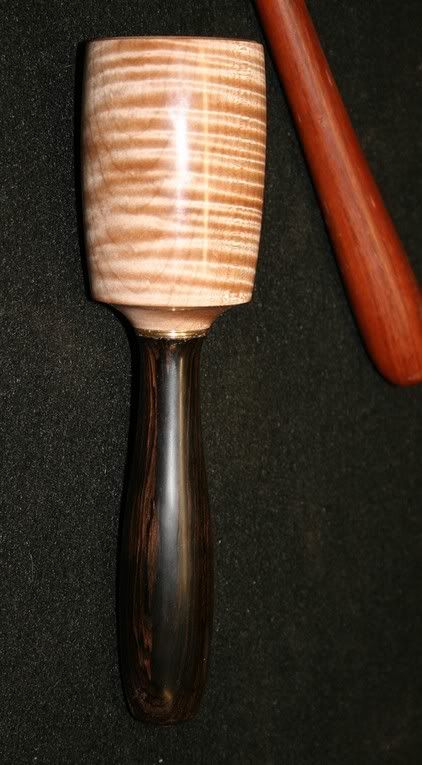
It is very well balanced, and I used it for some years. I no longer use it for bench chisels. It just lacks the control of a gennou-type hammer. For Western, un-hooped chisels I prefer my plane hammer, which has a hard nylon face - tough enough not to break, giving enough to not dent the wooden chisel handle, and just heavy enough (7 oz) to provide enough power ...
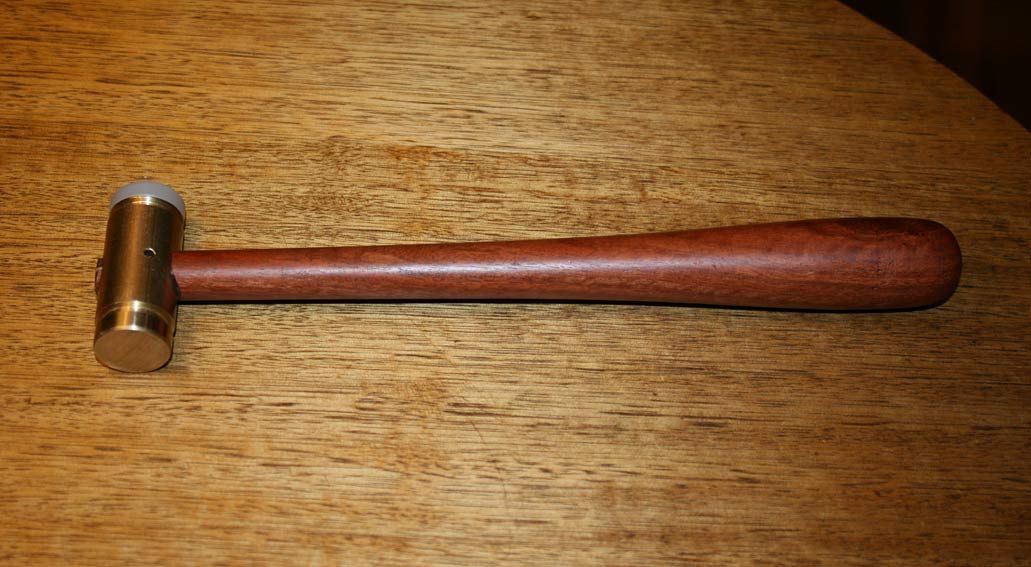
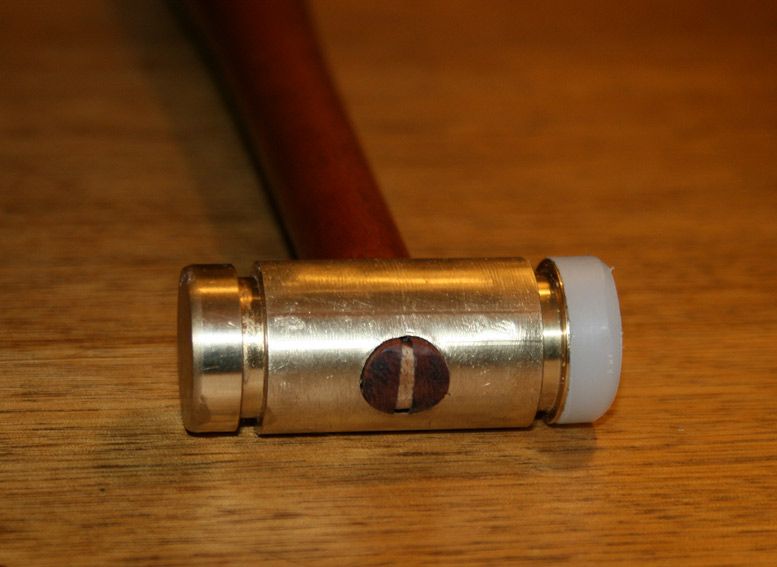
Regards from Perth
DerekVisit www.inthewoodshop.com for tutorials on constructing handtools, handtool reviews, and my trials and tribulations with furniture builds.
-
25th August 2015, 07:51 AM #7

I've got a cobbler's hammer I use to adjust some planes with. It has a shortish handle and a nice heft that I also use occasionally while assembling things, but I've never felt like using it to drive a chisel, it just doesn't feel right in the hand for that. Maybe if I made a gennou style handle for it that may change.
The 'broom handle' piece of Ironbark I've been using is only 23cm long and weighs in at 172gm, but gives just that bit more force over hand pushing that I have found useful taking small nibbles and when not looking for particularly deep or heavy cuts.
I figure there's something in the joiner/carver mallet design between hitting with endgrain and cross grain and I note a couple of threads earlier this year where home made joiners mallets have split along the grain, but thats probably more an issue with using the wrong species of Australian hardwoods since more traditional species like beech aren't readily available for us to experiment with.
-
25th August 2015, 11:30 AM #8
 GOLD MEMBER
GOLD MEMBER











- Join Date
- Aug 2011
- Location
- bilpin
- Posts
- 3,562

Choice of mallet is very much a personal thing. Once you get accustomed to a particular style most others feel a little odd. Personally, I prefer the carver's style mallet. The reason is simple - I've got used to them. But it goes a bit further than that. The nice thing with a carvers mallet is the taper of the head. When used close to the handle, the strike is much lighter or finer than at the extremity of the head. More sensitive if you like.
Another factor is the ease with which a new one can be spun up on the lathe in a matter of minutes. My preferred wood is Brigalow.
-
28th August 2015, 06:24 PM #9
 China
China











- Join Date
- Dec 2005
- Location
- South Australia
- Posts
- 4,475

Have a go at cutting a 100mm x 30mm x 80mm mortise in well seasoned chunk of Jarrah and you will quickly understand why a joiners mallet is so large
-
28th August 2015, 06:39 PM #10

So really it comes down to horses for courses.
Big jobs need a big hammer or mallet. Small jobs a delicately balanced device. Pig stickers need an almighty wallop, but your Japanese chisel a delicate tap.
Regards
PaulBushmiller;
"Power tends to corrupt. Absolute power corrupts, absolutely!"
-
28th August 2015, 07:24 PM #11

True, but why didn't an Australian form appear made of local woods made to deal with local woods. Why isn't there a monster Titan mallet to drive Titan chisels into mongrel Aussie hardwoods. All the joiners mallets I've seen seem to be old world beechwood.
With the hardwoods prone to split perhaps, why isn't the local big chisel driver of choice a heavy mallet made of cross grained hardwood specifically shaped to hit metal ringed Titans hard? Why perhaps isn't it shaped like a mallet for a Froe?
I'll eventually get around to turning a few Ironbark carving shaped mallets of various sizes to try out, but I'm still wondering about suitability or not of Ironbark.
-
28th August 2015, 09:28 PM #12
 Bushmiller;
Bushmiller;
"Power tends to corrupt. Absolute power corrupts, absolutely!"
-
28th August 2015, 10:59 PM #13

The reason for Beech in mallets and benches in Europe is simple - that's what was plentifully available. There are many woods that we have in Oz that are superior in terms of toughness and mass together.
For morticing in our local hardwoods, especially here in Western Australia - Jarrah, Karri, Marri, She-oak, etc - one benefits from a joiner's style mallet that has more mass than the average. Mine is 36oz. It is made from Jarrah and beefed up with brass at the sides. The faces are lined with leather to protect wooden handles, such as the RI oval bolstered mortice chisels.
This is the other extreme to a dovetail chisel gennou ...
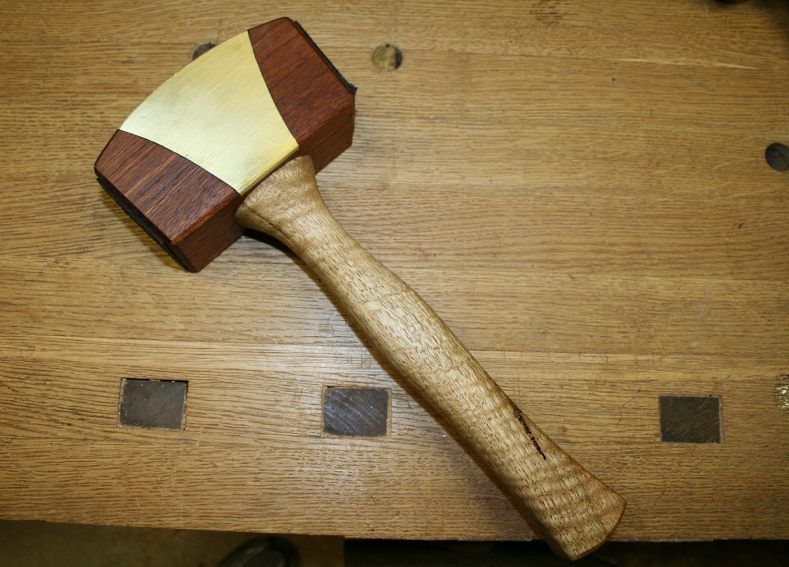
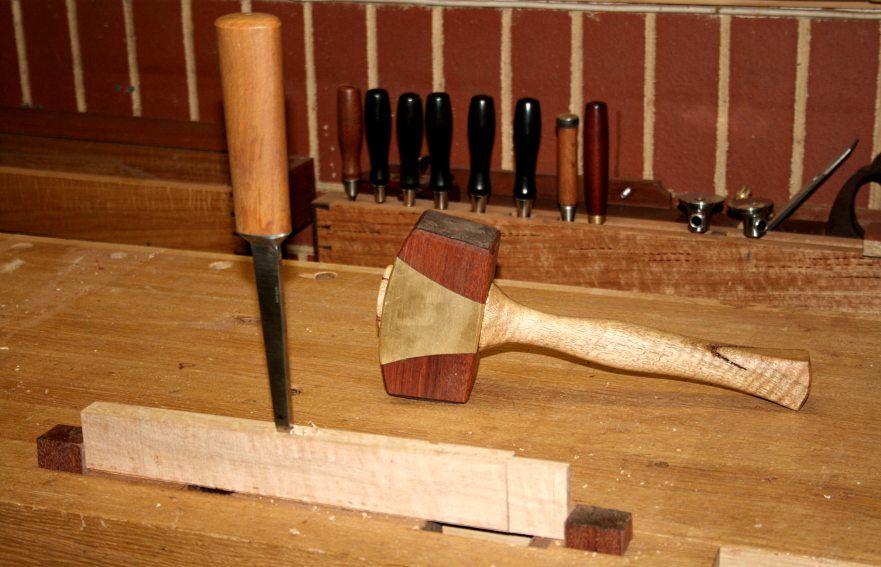
Link: http://www.inthewoodshop.com/ShopMad...ceChisels.html
Regards from Perth
DerekVisit www.inthewoodshop.com for tutorials on constructing handtools, handtool reviews, and my trials and tribulations with furniture builds.
-
29th August 2015, 02:52 AM #14

Derek
A very smart (not like the phone) mallet indeed. Another way to achieve weight and retain the compact size is to drill into the head of the mallet and pour molten lead into the hole. Place a plug in the top of the hole to disguise and retain. Probably either two or four holes is the best option to retain an even balance. The wood you have drilled out is now repalced with a metal weighing eleven times as much.
Regards
PaulBushmiller;
"Power tends to corrupt. Absolute power corrupts, absolutely!"
-
29th August 2015, 08:25 AM #15
 GOLD MEMBER
GOLD MEMBER

- Join Date
- Apr 2011
- Location
- McBride BC Canada
- Posts
- 3,543

What bushmiller said.
I've been carving for quite a while. I have two carving mallets with tapered polyethylene heads, one 12oz/375g ShopFox and the other, not much larger, 30oz/940g Wood-Is-Good with a cast lead core. I guess I could mess around and cast my own. Lead shot won't do it, that's used in "dead-blow" hammers. Beyond a full swing, I like the fact that I can hold the mallet head in my hand for full control and light touches.
Canada has not used pennies in several years now. Although just copper, a mass solidified with epoxy would be better than nothing.
Similar Threads
-
Dovetailing panels
By Normanj in forum ROUTER JIGSReplies: 2Last Post: 26th June 2009, 10:24 PM -
Diy dovetailing Jig
By sidewz in forum HOMEMADE TOOLS AND JIGS ETC.Replies: 2Last Post: 5th March 2009, 07:54 PM -
The $5 Dovetailing Vise
By derekcohen in forum HOMEMADE TOOLS AND JIGS ETC.Replies: 8Last Post: 7th December 2005, 03:49 AM -
hand dovetailing
By ditchy in forum WOODWORK - GENERALReplies: 28Last Post: 23rd February 2004, 10:14 PM



 Thanks:
Thanks: 
 Reply With Quote
Reply With Quote
